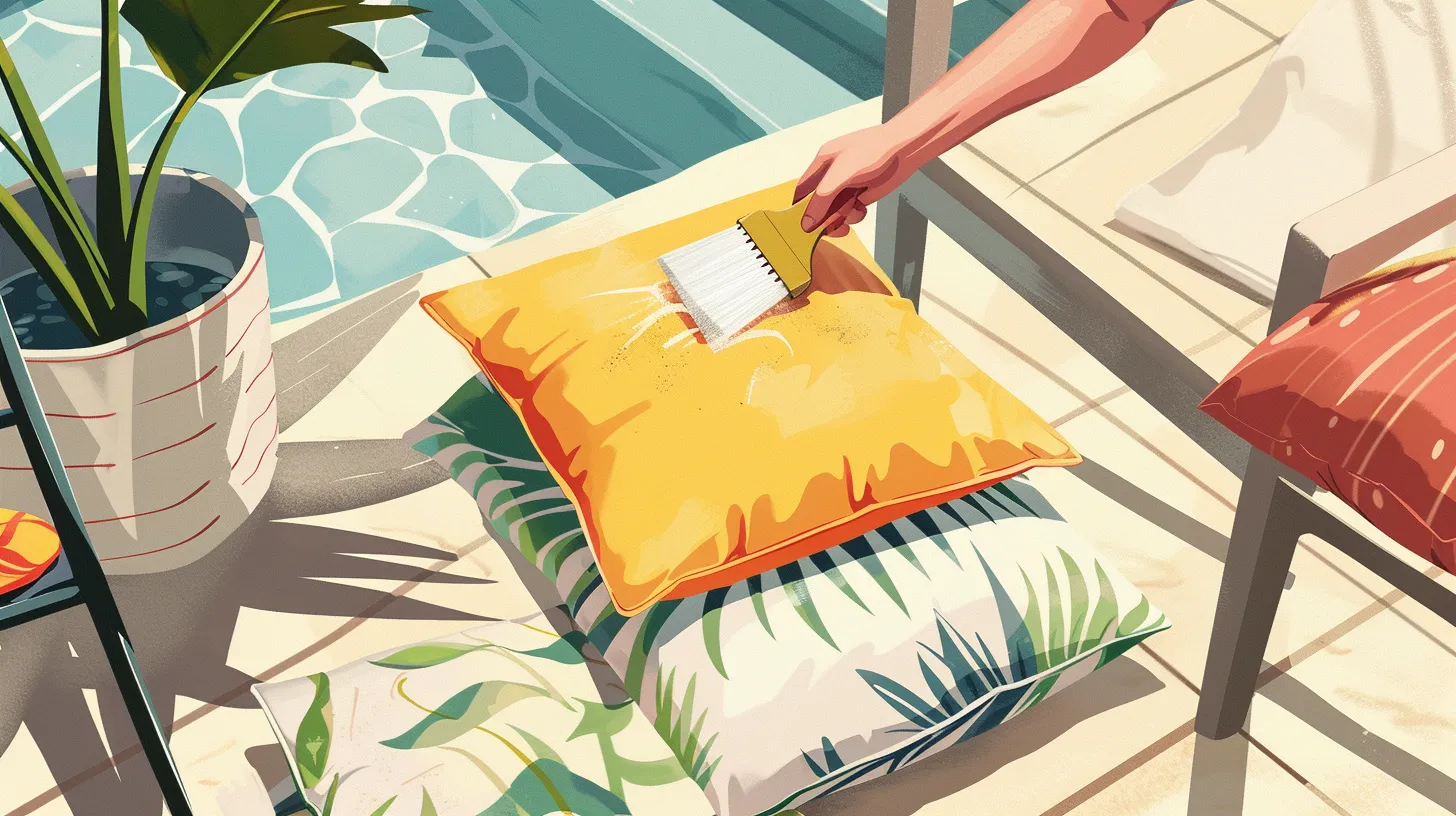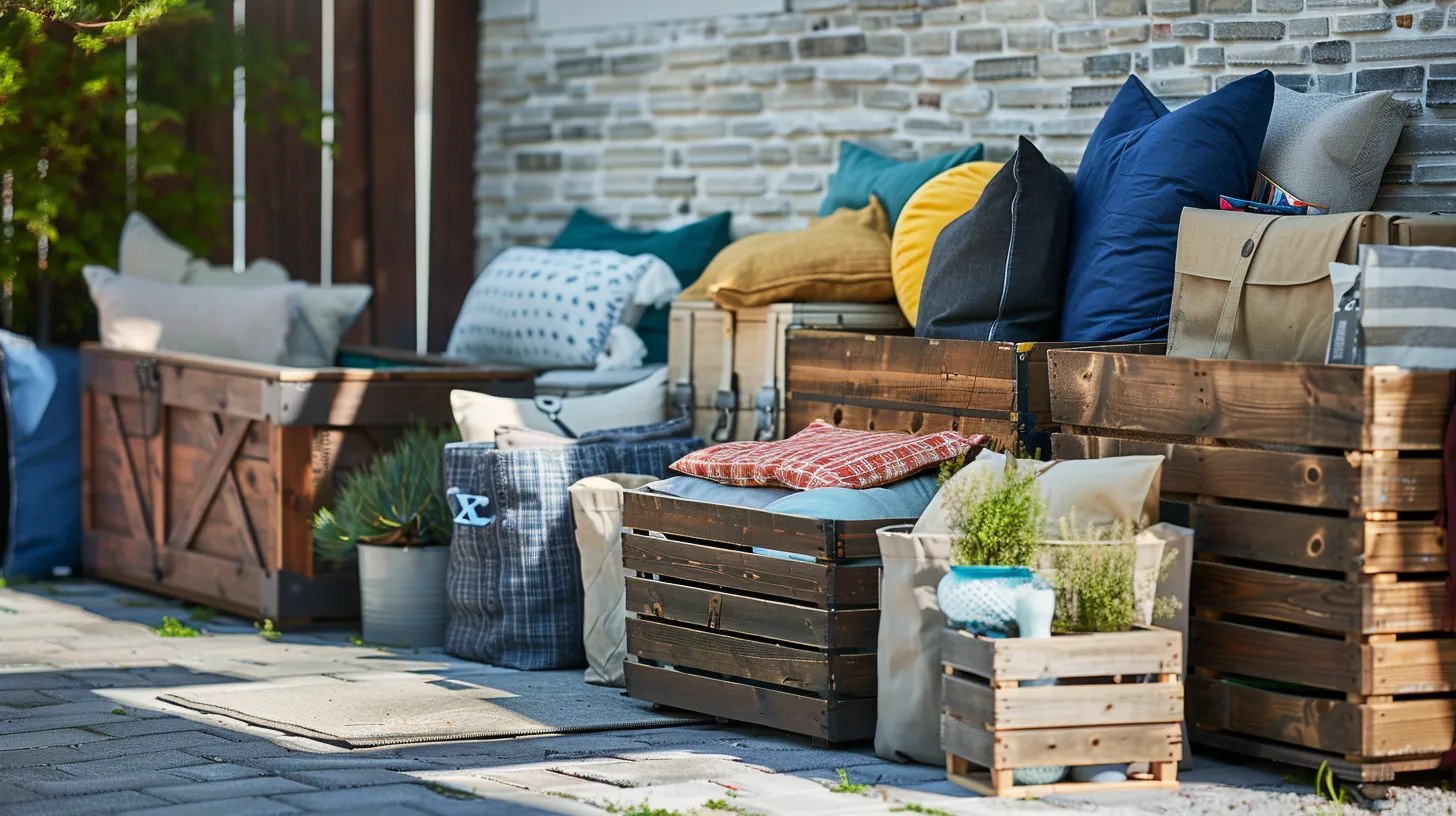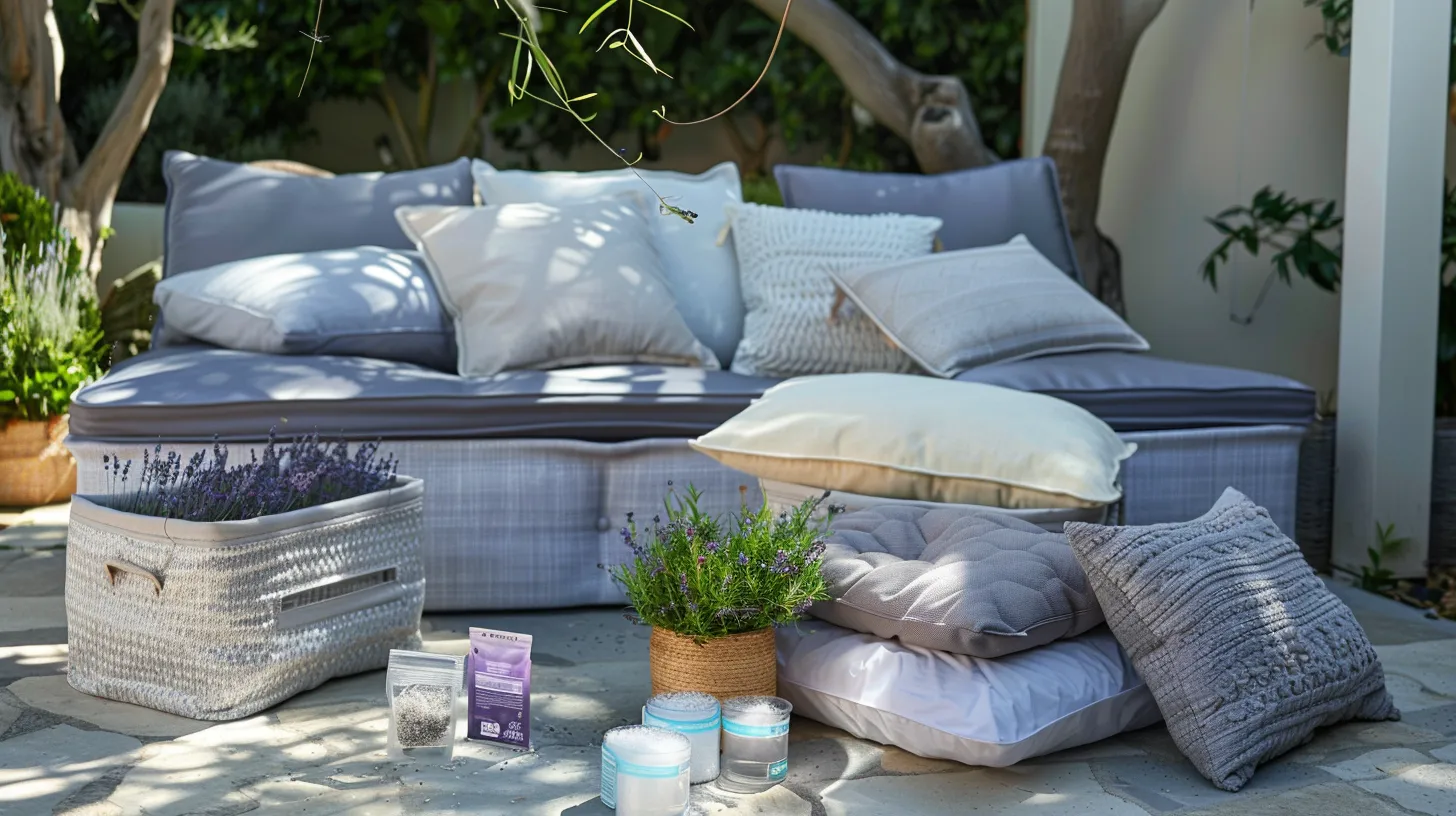To effectively store outdoor cushions, choose durable materials like Sunbrella fabric which resists fading, stains, and mildew. Prioritize thorough cleaning and drying of cushions before storage, utilizing machine washable covers . For storing, opt for either airtight containers to prevent moisture or breathable fabric bags to allow air circulation. Cushions should be stored in dry, room-temperature environments, off the ground to avoid moisture, and covered with weather-resistant materials . Additionally, regular seasonal maintenance and fabric protection are recommended for longevity. There are further insightful recommendations on organizing and maximizing storage space to explore next.
Understanding Cushion Materials

Selecting the right material is crucial for guaranteeing the longevity and durability of outdoor cushions. Sunbrella fabric , widely recognized for its superior quality, stands out as a prime choice for outdoor furnishings. Renowned for its exceptional durability , Sunbrella is engineered to resist the harsh elements that outdoor cushions are subjected to. This includes a strong resistance to fading, stains, mold , and mildew, which are common issues in outdoor environments.
Moreover, Sunbrella's vast array of patterns and colors enables homeowners to find the perfect match for their outdoor decor, blending functionality with aesthetic appeal. This versatility ensures that the cushions not only endure through varying weather conditions but also maintain their visual appeal over time .
RSH Decor, a company committed to quality, exclusively uses Sunbrella fabric for all its outdoor cushions. This partnership highlights a shared commitment to providing products that offer prolonged longevity and sustained performance . By opting for RSH Decor 's Sunbrella-equipped outdoor cushions, customers are investing in reliable, long-lasting outdoor textiles, designed to withstand the rigors of outdoor use while maintaining their beauty and integrity.
Cleaning Before Storage

Before storing your outdoor cushions for the season, it is vital to clean and dry them thoroughly to prevent mold and material degradation. Proper cleaning not only maintains the aesthetic appeal of your cushions but also enhances their longevity by minimizing the risk of mold growth during storage. Start by consulting the manufacturer's instructions specific to your cushion materials. This ensures that you use the appropriate cleaning techniques without damaging the fabric.
For removable covers, a machine wash might be suitable. Use a mild detergent and set your washer on a gentle cycle, then let them air dry completely. For non-removable covers, prepare a cleaning solution of soap and warm water. Gently scrub the surfaces to remove any dirt or debris. If you encounter stubborn stains or signs of mold, applying white vinegar or a diluted bleach solution can be effective. Be sure to test these stronger solutions on a small, inconspicuous area of the cushion first to avoid any discoloration or material damage.
Make sure all cushions are completely air-dried before proceeding to storage. This step is essential as any residual moisture can lead to mold growth, undermining all your cleaning efforts.
Selecting Proper Covers

To guarantee high-quality protection for your outdoor cushions , it is essential to choose the right type of cover. The selection between custom-fit and universal covers hinges on the specific needs of your patio furniture. Custom-fit covers provide a snug fit, enhancing protection by minimizing the exposure to moisture and debris, essential for keeping cushions dry and intact during storage. Conversely, universal covers offer flexibility, suitable for various furniture sizes, which can be a practical choice for non-standard furniture pieces.
The durability of the cover material is paramount. Tear-resistant fabrics such as ripstop fabric, solution-dyed polyester , high-density vinyl , acrylic-coated canvas , and PVC-backed polyester are top choices. These materials are not only robust against physical wear and tear but also provide excellent resistance against UV rays and inclement weather , preventing fading and discoloration of your cushions.
When storing outdoor cushions, the right cover material acts as a barrier against moisture and dirt, critical factors in prolonging the life and appearance of your patio furniture. Opting for the suitable tear-resistant cover is one of the most effective storage solutions to make sure your outdoor cushions remain in pristine condition.
Choosing Storage Containers

When selecting storage containers for outdoor cushions, it is important to take into account factors such as airtightness, breathability , and moisture control to guarantee maximum protection. Airtight containers , such as plastic bins or deck boxes, are excellent choices for safeguarding cushions against moisture and pests. These containers effectively prevent the entry of water and bugs, which can degrade the quality of the cushions over time.
For those living in high humidity areas, breathable options are advisable. Fabric storage bags or storage benches allow for air circulation, which helps in preventing mold and mildew buildup . To enhance moisture control within these storage containers, consider adding moisture-absorbing packets . These packets help in maintaining a dry environment inside the container, further protecting the cushions.
It's also important to place these storage containers in a dry, room-temperature area . Locations that fluctuate in temperature and humidity levels can affect the effectiveness of the storage solution. Proper placement ensures that the integrity of the storage containers and the effectiveness of moisture-absorbing packets are maximized, thereby extending the life of your outdoor cushions.
Ideal Storage Locations
Having discussed the selection of suitable storage containers , identifying the right locations for storing outdoor cushions is equally important. The best places to store patio furniture cushions are those that maintain a consistent temperature and humidity , which helps prevent mold and mildew. An ideal choice is a climate-controlled storage unit , as it offers a stable environment away from external fluctuations.
Alternatively, a finished basement can serve as an excellent storage location, provided it is dry and well-ventilated. This setting generally keeps the cushions away from harsh conditions that could promote dampness. For households without access to these options, breathable deck boxes represent a viable solution. These allow cushions to air dry completely, even in high humidity areas, while protecting them from direct exposure to environmental elements.
Furthermore, interior closets or spacious storage benches within the home can also be effective. These areas usually offer protection from extreme temperatures and direct sunlight, essential for cushion longevity . Remember, the key to effective storage is not just about keeping the cushions dry but also ensuring they are placed in locations that support their preservation over time.
Moisture and Pest Protection
Effective moisture and pest protection is crucial for maintaining the integrity of outdoor cushions during storage. To protect against moisture and pests, storing cushions in airtight containers or breathable fabric bags is a practical approach. Incorporating moisture-absorbing packets within these storage containers can greatly help to prevent mold and mildew, which thrive in damp environments.
It's also important to regularly inspect storage areas for any signs of pests. Utilizing natural repellents such as cedar chips can deter pests without harming the cushions with harsh chemicals. Elevating cushions at least six inches off the ground in a dry location further safeguards them from moisture accumulation and pest infestations.
For additional protection, opt for weather-resistant materials when choosing cushions or consider using protective covers, especially during adverse weather conditions. These covers not only shield the cushions from the elements but also contribute to their longevity by providing an additional layer of defense against moisture and pests.
Organizing Cushions Effectively
After guaranteeing your outdoor cushions are protected from moisture and pests, the next step is to organize them efficiently for storage. To maximize the use of your storage area, organize cushions by size and shape. This simple method not only keeps your space tidy but also makes it easier to retrieve specific cushions when needed.
Utilizing storage bins with dividers offers a great option to separate and protect each cushion . These compartments help ensure the materials remain clean and undamaged. It is also advisable to label each container or bag with its contents. This step will save you time when you need to find a particular cushion, and it helps in maintaining order within your storage space.
To further optimize storage, consider grouping cushions by color or pattern. This approach not only facilitates quick access but also helps in keeping similar styles together, which can be particularly useful for coordinated sets. Additionally, for those looking to save even more space, vacuum-sealing bags can be an effective solution. These bags minimize air exposure, which is essential in preventing mold and mildew growth, and allow for compact storing of outdoor cushions .
Seasonal Maintenance Routines
To guarantee the longevity of outdoor cushions , it is essential to follow seasonal maintenance routines that include inspection, cleaning, and proper storage. Inspecting cushions for signs of wear or damage at the end of each season ensures that any issues can be addressed promptly.
Cleaning is vital; removing dirt and debris before storing helps prevent the growth of mold and mildew during off-seasons. It is advisable to apply a fabric protector , which aids in repelling water, stains, and damaging UV rays, thereby extending the lifespan of the cushions.
When it comes to storing, place the outdoor cushions in a dry, room-temperature environment away from direct sunlight to maintain their quality. Utilizing fabric bags for storage can further shield the cushions from dust and pests, ensuring they remain in pristine condition.
Adhering to these seasonal maintenance routines consistently each year helps preserve the cushions' aesthetics and functionality, readying them for use whenever needed. By dedicating time to the proper cleaning, application of fabric protector, and thoughtful storing of your outdoor cushions, you safeguard your investment and enhance your outdoor living space for years to come.
Handling Unexpected Weather
Unexpected weather changes can pose a significant risk to outdoor cushions , necessitating proactive measures to guarantee their protection. When dealing with the unpredictability of weather, having a strategy in place is essential to safeguard these valuable items from potential damage. Utilizing weather-resistant covers is an effective method to shield cushions from rain, snow, and even the sun's intense UV rays , thereby preventing premature wear and tear.
To further protect cushions during severe weather conditions , it is advisable to bring them indoors . This simple action can prevent the extensive damage that harsh elements might cause, including water damage and the subsequent risk of mold growth . Regularly inspecting cushions after unexpected weather events is also vital to manage any moisture that could have seeped in, ensuring any issues are addressed promptly to maintain the cushions' condition.
Investing in quick-drying cushion materials can greatly enhance damage prevention efforts . These materials are designed to repel water more effectively, reducing drying time and minimizing the likelihood of mold developing. By adopting these proactive practices, homeowners can ensure their outdoor cushions remain in top condition, ready to enhance outdoor spaces without the constant worry of weather-related damage.
Long-Term Preservation Tips
While handling unexpected weather effectively protects outdoor cushions in the short term, implementing long-term preservation strategies is key to maintaining their condition over time.
One effective method to store outdoor cushions is using airtight containers equipped with moisture-absorbing packets . This approach shields the cushions from moisture and pests, essential for keeping them mold-free and extending their lifespan. Additionally, it is advisable to elevate cushions at least six inches off the ground. This elevation prevents moisture accumulation and protects against pest infestations, further preserving the cushions' integrity.
For those seeking ideal conditions for their cushions, consider renting a climate-controlled storage unit or utilizing an interior closet. These environments offer stable temperatures and humidity levels , perfect for preventing material degradation over extended periods. Furthermore, bringing outdoor cushions indoors overnight regularly can significantly contribute to their longevity. This habit protects them from nightly dew and potential pest damage, maintaining their quality.
Adhering to these proper maintenance practices during storage not only ensures that your cushions remain clean and comfortable but also saves money by reducing the need for frequent replacements . With these strategies, you can enjoy durable, inviting outdoor seating season after season.










